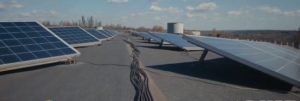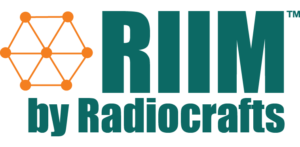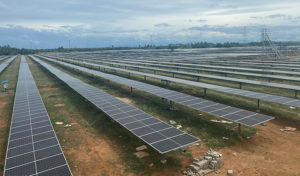Solar is one of the many renewable energy resources which plays an important role in reducing greenhouse gas emissions and lowering our carbon footprint helping us negate the effects of climate change. Furthermore, solar energy can improve the quality of the air we breathe, reduce wasteful water use from energy production, and is critical in protecting many wildlife ecosystems. The solar industry also offers global economic benefits, for example, the cost of solar panels has dropped in recent years including the upfront costs of installing them, making solar power a more accessible resource option. This allows individuals, businesses, and communities world-wide to reap the benefits of solar power including reductions in electricity bills, maintenance costs, and more. Furthermore, the solar industry has created numerous jobs around the world which in turn boosts economic growth and provides employment opportunities.

The rapid growth of the solar industry in recent years has been nothing short of remarkable. However, in this blog post, we will focus on solar tracker segment specifically, which have grown strongly in the recent decade from $6.75 billion in 2023 to $7.41 billion in 2024 at a compound annual growth rate (CAGR) of 9.8%. The market is expecting to see continued growth in the next few years, reaching $10.71 billion in 2028 and at a CAGR of 9.6%. This massive growth can be attributed to several factors including advances and innovation in tracker control technologies, expansion of solar installations worldwide, cost reductions in solar technologies and equipment, incentive programs and policies supporting renewable energy adoption and more efficient energy use, integration of energy storage, emergence of new solar markets, and more.
In this blog post we will dive deeper into what solar tracking actually means and the benefits it provides to a solar installation, then, we will discuss how you can implement an efficient solar tracking system in your installation site, followed by an introduction of Radiocrafts’ market-leading Sub-GHz solution, RIIM, optimized for wireless solar tracker systems. Finally, we will compare RIIM to other wireless technologies such as ZigBee, LoRa, and Wi-SUN.
You can also read a more in depth dive into wireless technology options and their performance factors for Solar Tracking Installations in our Wireless Technology Selection Guide For Solar Tracking!
What is Solar Tracking?
A solar tracker is a system that positions solar panels at a specific and optimized angle to always remain in a perpendicular alignment with the sun’s rays. In other words, the solar tracker adjusts the direction in which a solar panel is facing according to the position of the sun in the sky. When the solar panel is perpendicular to the sun, more sunlight strikes the panel in a manner that less light is reflected and therefore, more energy is absorbed. That absorbed energy can then be converted into power.
![]()
The solar tracker systems use sensors to monitor the position of the sun. These sensors can be based on various technologies such as light-dependent resistors (LDRs), photodiodes, or systems which use GPS or electronic compasses. The data processing is done by a control system such as a microcontroller or computer which calculates the optimal position for the solar panels based on the sun’s position. The control system then sends commands to the actuator mechanism of the solar tracker which is responsible for adjusting the position of the solar panels. This actuator could use motors, gear, or other mechanical means to tilt the panels. Advanced solar trackers can include additional components such as safety mechanisms or wind sensors to optimize performance and protect the panels from extreme weather conditions like hailstorms or extreme wind.
Solar trackers can be controlled in two different ways, either based on previously computed sun trajectories (open-loop control) or through using a solar radiation sensor to control the orientation of the system (closed-loop control). In open-loop control, the movement of the sun is predicted through using astronomic relationships which are programmed into a microprocessor so that the microprocessor can calculate the position of the sun at any given time. In closed-loop control, the controllers use a solar sensor to identify the position of the sun. The sensitive are typically composed of photosensitive components mounted on top of the solar panels. The issue here is that the solar trackers can get confused under conditions with low sunlight such as during cloudy days or during dawn/sunset. Therefore, in this case, it is essential to use a supportive system which can help in controlling the rotation of the solar tracker motors until the correct orientation is restored again.
![]()
Now that we know what solar trackers are, what are the main benefits they can offer for a solar farm installation?
What Benefits Does Solar Tracking Offer For Your Solar Installation?
Solar trackers offer a huge amount of benefits when it comes to power generation and cost reductions for your solar farm installation. A few of these benefits include:
- Improved efficiency – Solar trackers can improve the performance of solar panels by up to 40%, which translates to increased solar energy generation.
- Installation location – Solar trackers are optimal for installations with high altitude, where the sun’s position varies a lot during the year. The ability to rotate the solar panels makes solar trackers well suited to adapt to different seasons, maximizing solar energy production in any geographic location.
- Take full advantage of sunlight hours – The high capacity of solar tracking allows solar panels to make the most out of every hour of sunlight, increasing energy production in the early mornings and late evenings as well, optimizing the performance further.
- Life expectancy – With the correct maintenance practices and advancements in technology, solar trackers can prolong the life expectancy of solar panels as mechanical and thermal stress is reduced.
- Optimized land usage – Solar trackers generate more electricity in the same amount of space needed for a fixed-tilt system, making them ideal for optimizing land usage.
- Varied installations – There are many kinds of solar trackers, but the two most common types are single-axis trackers (allows movement of solar trackers in one direction, typically from east to west) and dual-axis trackers (movement in two directions, both from east to west and from north to south). Each type provides a unique optimal fit for a specific solar installation depending on the installation size, weather, degree of latitude and electrical wiring requirements.
- Time of Use electricity rates – Solar trackers are beneficial in areas with Time of Use electricity rates because more energy will be produced during peak hours, which means you will not have to pay for grid energy when it is most expensive.

These are just a few of many reasons why solar trackers can offer a competitive advantage in your solar farm installation. But now the question is, how do I install a solar tracker system in an optimal way to get the most of it? Should you go for wireless solar tracker systems or wired solutions?
Wireless Versus Wired Solutions?
In today’s large-scale solar tracker installations where you find up to hundreds of thousands of solar trackers in one installation site, cabling solutions are still the norm, which involve intricate networks of fiber optic loops and kilometres of cables, including, RS485, electrical, and fiber optic cables buried underground. However, wireless technologies are starting gain major traction, offering numerous benefits for such installations.
Wired cabling solution can pose several challenges such as susceptibility to lightning ground loops and lightning strikes, which can disrupt communication if a cable connecting multiple solar trackers fails. In addition, the cable repair and replacement process incurs substantial costs and is labour-intensive.

From these challenges, there is a growing interest in wireless solar tracker systems due to their significant installation flexibility and cost savings. While the wired approach typically takes several days and considerable manpower to complete, the wireless alternatives offer quick and easy installation and adaptability. These advantages are the driving force for the increasing adoption of wireless solutions, particularly as demand rises for seamless and efficient system deployments.
Wireless Technologies For Solar Tracker Installations
There are numerous wireless technologies available today, each which offers unique benefits to the specific needs of each wireless solar tracker system installer. Today, we will highlight one of Radiocrafts’ Sub-GHz mesh solutions, RIIM, which has been optimized throughout the years to offer a market-leading solution for solar trackers. We will also compare RIIM to other technologies including ZigBee, Wi-Sun, and LoRa.
You can also read a more in depth dive into wireless technology options and their performance factors for Solar Tracking Installations in our Wireless Technology Selection Guide For Solar Tracking!

What are the benefits of the RIIM Sub-GHz mesh solution for wireless solar tracker systems?
- Simplify your installation and reduce cabling costs significantly with up to a few thousand solar trackers per gateway point.
- Cover an entire solar field, including areas with uneven terrain, with Sub-GHz mesh which offers long range and solid penetration properties through solar tracker beams and reduced panel reflections.
- Send and receive quick responses to dangerous weather conditions, such as, setting the solar trackers into safe position during high-winds or a hailstorm with efficient and low latency downlink control capabilities.
- You can also have several RIIM mesh networks operating in close proximity to each other with minimal data loss at a reliability rate of 99.99% successful packets delivered.
- Take advantage of low latency communication between solar trackers and the controller enabled by the low number of mesh hops required to cover an entire solar farm.
- Send fast acting updates of critical solar tracker parameters to your entire network through efficient over-the-air updates which works in under 3 minutes.
Radiocrafts visited one of our top-tier solar tracker customers to assist in commissioning a large-scale installation. The results we will share with you below showcase why RIIM Sub-GHz mesh is an optimal wireless technology for wireless solar tracker systems.

Throughout the deployment process we were able to get an average data transmission latency of 10 – 20 milliseconds for a single mesh hop. For 4 mesh hops, the average latency was around 100 – 120 milliseconds. To perform firmware over-the-air updates, the latency was as low as 3 minutes.
In terms of commissioning, you have the option of placing a singular gateway in the middle of the solar farm which can cover the entire field, or you can use sector antennas to partition the field into different sections.

Sector antennas are used to split the solar farm into different sections, for example, in this installation we used 3 sector antennas meaning we split the solar farm into 3 different sections, all covered by the same gateway point. The benefit of using the sector antennas is that you will get one third of the number of gateway placements required to run the network and a third of the number of fiber cables to lay out which leads simplifies the installation and decreases cost significantly. This means that you can also have a few thousand devices connected to a single gateway point with such an installation.
![]()
But how does RIIM compare to other popular technologies in the solar tracking market?
RIIM vs ZigBee vs LoRa vs Wi-SUN For Solar Tracking
So how does RIIM compare to other popular technology choices in the solar tracking market? A few of the most popular choices include ZigBee, Wi-SUN, and LoRa.

RIIM vs Zigbee:
- RIIM offers longer range because it uses sub-GHz frequency bands as opposed to the 2.4 GHz frequency band used by ZigBee.
- RIIM has more robust and reliable communication and is more scalable than ZigBee because it uses TSCH (time-synchronized channel hopping) in the MAC layer compared to CSMA/CS which is used in ZigBee.
- RIIM can handle many more devices in the network compared to ZigBee. One main reason for this is because RIIM uses advanced RPL mesh routing while Zigbee uses AODV or tree routing.
- RIIM was designed for industrial use while Zigbee was designed for consumer applications.
- RIIM networks are easier to commission because they handle channel assignments automatically while Zigbee requires manual channel assignment.
RIIM vs Wi-SUN:
- RIIM uses TSCH (Time-Synchronized Channel Hopping) while Wi-SUN uses USCH (Un-Synchronized Channel Hopping). USCH is best suited when devices are moving rapidly (time synchronization not feasible). For large solar installations with stationary solar trackers, the use of TSCH offers a huge advantage in reducing interference and packet collisions.
- Wi-SUN does not support AFA (Adaptive Frequency Agility), which is important for high data requirement applications such as solar tracking, allowing you to surpass the 1% duty cycle limitation in Europe up to 37%. In other words, since RIIM supports AFA, instead of sending just 1 packet to the gateway every 4 seconds, you can send up to 37 packets every 4 seconds, for example.
- RIIM simplifies commissioning of deployments because it uses a security model based on symmetric key cryptography AES-128, which is easily understood and adopted. The Wi-SUN security model is based on X.509 for asymmetric cryptography, which adds a lot of complexity and cost.
- RIIM can be tuned for customer specific requirements, for example, low latency safe position of solar panels while Wi-SUN is a standard that is not easily tweakable.
- RIIM can offer accurate time information, reducing the need for GPS based timekeeping. Wi-SUN is inherently unsynchronized.
RIIM vs LoRa:
- RIIM is designed for industrial SCADA while LoRa is optimized for infrequent sensor reporting (For example, a water meter reporting a small packet 12 times a day).
- RIIM allows you to both control your solar trackers in a fast and efficient manner while also sending reporting data up to the gateway because it has the same capacity on downlink (gateway to device communication) and uplink (devices to gateway communication) communication. LoRa has severely limited downlink communication.
- RIIM has the data capacity to do fast firmware over-the-air updates while LoRa takes much longer to achieve this.
- RIIM supports higher reliability in large wireless solar tracker systems where it is of paramount importance to avoid interference and packet collisions because it is tightly time synchronized while LoRa is not. Because LoRa is not time synchronized, it will have the same problem as Wi-SUN with more packet collisions and interference.
2.4 GHz has a long track record for solar tracking, but sub-GHz solutions are starting to become adopted by this market as companies begin to see the benefits going down in frequency can offer for their large-scale wireless solar tracker systems.
What To Take Away From This?
Solar tracking is a rapidly growing market for various reasons, but most importantly, because it has made substantial strides in our efforts to combat climate change, to reduce our carbon footprint, and to lower costs while increasing efficiency in our efforts to use energy in a more efficient manner. Advancements in the solar tracking market are moving towards wireless solar tracker systems and technologies as innovation in this field flourishes because it offers a more effective and cost friendly solution to the wired solution counterpart we are using today. One of these wireless solutions is the RIIM sub-GHz mesh technology from Radiocrafts which offers market-leading long range, low latency, and unmatched reliable communication for highly scalable wireless solar tracker systems. We also compare RIIM with other technologies such as ZigBee, LoRa, and Wi-SUN.
